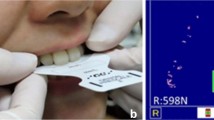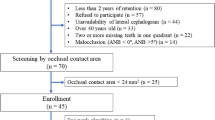Abstract
The purpose of this study was to clarify the presence or absence of gender differences in masticatory function in elderly adults with completely natural dentition. Fifty-six elderly adults aged 65 years and older (elderly group) and 60 young adults in their 20–40 s (young group) with natural dentition participated in this study. The maximum occlusal force on the habitual chewing side was measured using dental prescale. Next, the amount of glucose extraction when subjects chewed a gummy jelly on their habitual chewing side for 20 s was measured. The maximum occlusal force and masticatory performance in the elderly and young groups were compared between males and females. The relationship between the maximum occlusal force and masticatory performance was also investigated. The maximum occlusal force in the elderly and young groups was larger in males than in females, and the difference was significant. The amount of glucose extraction in the elderly and young groups was higher in males than in females, and the difference was significant. Regarding the relationship between the maximum occlusal force and the amount of glucose extraction, there was a significant positive correlation. These results suggest that there are gender differences in the masticatory function of the elderly adults with completely natural dentition, and these differences need to be noted in the evaluation of masticatory function.
Similar content being viewed by others
References
Miyaura K, Morita M, Matsuka Y, Yamashita A, Watanabe T. Rehabilitation of biting abilities in patients with different types of dental prostheses. J Oral Rehabil. 2000;27:1073–6.
Goshima K, Lexner MO, Thomsen CE, Miura H, Gotfredsen K, Bakke M. Functional aspects of treatment with implant-supported single crowns: a quality control study in subjects with tooth agenesis. Clin Oral Implants Res. 2010;21:108–14.
Kosaka T, Ono T, Kida M, Kikui M, Yamamoto M, Yasui S, Nokubi T, Maeda Y, Kokubo Y, Watanabe M, Miyamoto Y. A multifactorial model of masticatory performance: the Suita study. J Oral Rehabil. 2016;43:340–7.
Sun X, Zhai JJ, Liao J, Teng MH, Tian A, Liang X. Masticatory efficiency and oral health-related quality of life with implant-retained mandibular overdentures. Saudi Med J. 2014;35:1195–202.
Ishida K, Nogawa T, Takayama Y, Saito M, Yokoyama A. Does neuroticism influence oral health-related QOL in patients with removable partial dentures? JDR Clin Trans Res. 2017;2:370–5.
Kon K, Shiota M, Sakuyama A, Ozeki M, Kozuma W, Kawakami S, Kasugai S. Evaluation of the alteration of occlusal distribution in unilateral free-end and intermediate missing cases. J Oral Implantol. 2017;43:3–7.
Kuramochi A, Shiga H. Effect of denture treatment on masticatory movement in patients with complete dentures. J Prosthodont Res. 2019;63:245–9.
Shiga H, Kobayashi Y, Arakawa I, Shonai Y. Selection of food and chewing side for evaluating masticatory path stability. Odontology. 2003;91:26–30.
Takahashi M, Takahashi F, Morita O. Evaluation of the masticatory part and the habitual chewing side by wax cube and bite force measuring system (Dental Prescale®). J Jpn Prosthodont Soc. 2008;52:513–20.
Shiga H, Kobayashi Y, Katsuyama H, Yokoyama M, Arakawa I. Gender difference in masticatory performance in dentate adults. J Prosthodont Res. 2012;56:166–9.
Müller F, Hernandez M, Grütter L, Aracil-Kessler L, Weingart D, Schimmel M. Masseter muscle thickness, chewing efficiency and bite force in edentulous patients with fixed and removable implant-supported prostheses: a cross-sectional multicenter study. Clin Oral Implants Res. 2012;23:144–50.
Bae JC, Jeong SH, Jeong CM, Huh JB. Comparison of the masticatory functions of complete dentures and implant-retained overdentures. Int J Prosthodont. 2015;28:345–7.
Tanaka Y, Shiga H. Masticatory performance of the elderly as seen from differences in occlusal support of residual teeth. J Prosthodont Res. 2018;62:375–8.
Ikebe K, Nokubi T, Morii K, Kashiwagi J, Furuya M. Association of bite force with ageing and occlusal support in older adults. J Dent. 2005;33:131–7.
Motegi E, Nomura M, Tachiki C, Miyazaki H, Takeuchi F, Takaku S, Abe Y, Miyatani M, Ogai T, Fuma A, Fukagawa H, Kano M, Sueishi K. Occlusal force in people in their sixties attending college for elderly. Bull Tokyo Dent Coll. 2009;50:135–40.
Chong MX, Khoo CD, Goh KH, Rahman F, Shoji Y. Effect of age on bite force. J Oral Sci. 2016;58:361–3.
Lundgren D, Laurell L. Occlusal force pattern during chewing and biting in dentitions restored with fixed bridges of cross-arch extension. I. Bilateral end abutments. J Oral Rehabil. 1986;13:57–71.
Peyron MA, Blanc O, Lund JP, Woda A. Influence of age on adaptability of human mastication. J Neurophysiol. 2004;92:773–9.
Salsench J, Martínez-Gomis J, Torrent J, Bizar J, Samsó J, Peraire M. Relationship between duration of unilateral masticatory cycles and the type of lateral dental guidance: a preliminary study. Int J Prosthodont. 2005;18:339–46.
Tamura K, Shiga H. Gender differences in masticatory movement path and rhythm in dentate adults. J Prosthodont Res. 2014;58:237–42.
Ono T, Hori K, Ikebe K, Nokubi T, Nago S, Kumakura I. Factors influencing eating ability of old in-patients in a rehabilitation hospital in Japan. Gerodontology. 2003;20:24–31.
Takahashi M, Koide K, Arakawa I, Mizuhashi F. Association between perioral muscle pressure and masticatory performance. J Oral Rehabil. 2013;40:909–15.
Isabel CA, Moysés MR, van der Bilt A, Gameiro GH, Ribeiro JC, Pereira LJ. The relationship between masticatory and swallowing behaviors and body weight. Physiol Behav. 2015;151:314–9.
Scudine KGO, Pedroni-Pereira A, Araujo DS, Prado DGA, Rossi AC, Castelo PM. Assessment of the differences in masticatory behavior between male and female adolescents. Physiol Behav. 2016;163:115–22.
Miyaura K, Matsuka Y, Morita M, Yamashita A, Watanabe T. Comparison of biting forces in different age and sex groups: a study of biting efficiency with mobile and non-mobile teeth. J Oral Rehabil. 1999;26:223–7.
Ikebe K, Matsuda K, Kagawa R, Enoki K, Yoshida M, Maeda Y, Nokubi T. Association of masticatory performance with age, gender, number of teeth, occlusal force and salivary flow in Japanese older adults: is ageing a risk factor for masticatory dysfunction? Arch Oral Biol. 2011;56:991–6.
Izuno H, Hori K, Sawada M, Fukuda M, Hatayama C, Ito K, Nomura Y, Inoue M. Physical fitness and oral function in community-dwelling older people: a pilot study. Gerodontology. 2016;33:470–9.
Takagi D, Watanabe Y, Edahiro A, Ohara Y, Murakami M, Murakami K, Hironaka S, Taniguchi Y, Kitamura A, Shinkai S, Hirano H. Factors affecting masticatory function of community-dwelling older people: Investigation of the differences in the relevant factors for subjective and objective assessment. Gerodontology. 2017;34:357–64.
Morita K, Tsuka H, Kato K, Mori T, Nishimura R, Yoshida M, Tsuga K. Factors related to masticatory performance in healthy elderly individuals. J Prosthodont Res. 2018;62:432–5.
Palinkas M, Nassar MS, Cecílio FA, Siéssere S, Semprini M, Machado-de-Sousa JP, Hallak JE, Regalo SC. Age and gender influence on maximal bite force and masticatory muscles thickness. Arch Oral Biol. 2010;55:797–802.
Lepley CR, Throckmorton GS, Ceen RF, Buschang PH. Relative contributions of occlusion, maximum bite force, and chewing cycle kinematics to masticatory performance. Am J Orthod Dentofacial Orthop. 2011;139:606–13.
Hatch JP, Shinkai RS, Sakai S, Rugh JD, Paunovich ED. Determination of masticatory performance in dentate adults. Arch Oral Biol. 2001;46:641–8.
Komino M, Shiga H. Changes in mandibular movement during chewing of different hardness foods. Odontology. 2017;105:418–25.
Shiga H, Komino M, Uesugi H, Sano M, Yokoyama M, Nakajima K, Ishikawa A. Comparison of two dental prescale systems used for the measurement of occlusal force. Odontology. 2020;108:676–80.
Flores-Orozco EI, Tiznado-Orozco GE, Osuna-González OD, Amaro-Navarrete CL, Rovira-Lastra B, Martinez-Gomis J. Lack of relationship between masticatory performance and nutritional status in adults with natural dentition. Arch Oral Biol. 2016;71:117–21.
Okamoto N, Amano N, Nakamura T, Yanagi M. Relationship between tooth loss, low masticatory ability, and nutritional indices in the elderly: a cross-sectional study. BMC Oral Health. 2019;19:110–20.
Sagawa K, Furuya H, Ohara Y, Yoshida M, Hirano H, Iijima K, Kikutani T. Tongue function is important for masticatory performance in the healthy elderly: a cross-sectional survey of community-dwelling elderly. J Prosthodont Res. 2019;63:31–4.
Funding
The authors received no support from any grant.
Author information
Authors and Affiliations
Corresponding author
Ethics declarations
Conflict of interest
The authors declare that they have no conflict of interest.
Ethic statement
This study was conducted with the approval of the Ethics Committee of the Faculty of Life and Dentistry, Nippon Dental University (NDU-T2020-31).
Informed consents
Informed consent was obtained from all subjects after they were received information on the general nature of the study.
Additional information
Publisher's Note
Springer Nature remains neutral with regard to jurisdictional claims in published maps and institutional affiliations.
Rights and permissions
About this article
Cite this article
Sano, M., Shiga, H. Gender differences in masticatory function in elderly adults with natural dentition. Odontology 109, 973–978 (2021). https://doi.org/10.1007/s10266-021-00622-3
Received:
Accepted:
Published:
Issue Date:
DOI: https://doi.org/10.1007/s10266-021-00622-3




